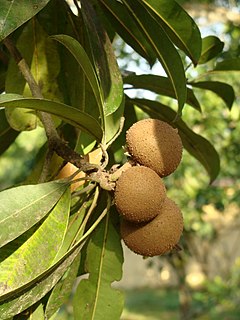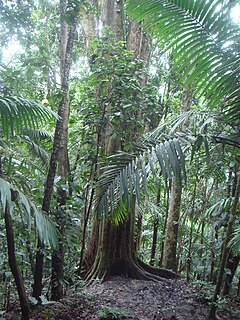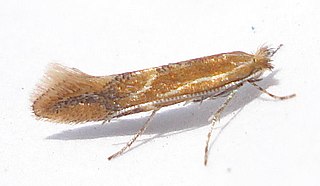Níspero, nipero, nêspera and mespel are terms referring to certain fruit-bearing trees, or to their fruit in particular:

In botany, a tree is a perennial plant with an elongated stem, or trunk, supporting branches and leaves in most species. In some usages, the definition of a tree may be narrower, including only woody plants with secondary growth, plants that are usable as lumber or plants above a specified height. Trees are not a taxonomic group but include a variety of plant species that have independently evolved a woody trunk and branches as a way to tower above other plants to compete for sunlight. Trees tend to be long-lived, some reaching several thousand years old. In wider definitions, the taller palms, tree ferns, bananas, and bamboos are also trees. Trees have been in existence for 370 million years. It is estimated that there are just over 3 trillion mature trees in the world.
- Common medlar (Mespilus germanica), the origin of the term (called Mispel in many Germanic languages, mispeli in Finnish, nespolo in Italian, etc.)
- Loquat (Eriobotrya japonica), widely traded under these names today, in particular in temperate countries
- Sapodilla (Manilkara zapota), often known by these terms in tropical countries in Latin America
- Manilkara huberi a tropical fruit

The loquat is a species of flowering plant in the family Rosaceae, a native to the cooler hill regions of China to south-central China. It is also quite common in Japan, Korea, hilly Regions of India (Himachal), Potohar and foothill regions of Pakistan and some can be found in some Northern part of the Philippines, and hill country in Sri Lanka. It can also be found in some southern European countries such as Cyprus, Malta, Italy, Spain and Portugal; and several Middle Eastern countries including Syria, Israel, Lebanon, and Turkey.

Latin America is a group of countries and dependencies in the Western Hemisphere where Romance languages such as Spanish, Portuguese, and French are predominantly spoken; it is broader than the terms Ibero-America or Hispanic America. The term "Latin America" was first used in an 1856 conference with the title "Initiative of the America. Idea for a Federal Congress of the Republics", by the Chilean politician Francisco Bilbao. The term was used also by Napoleon III's French government in the 1860s as Amérique latine to consider French-speaking territories in the Americas, along with the larger group of countries where Spanish and Portuguese languages prevailed, including the Spanish-speaking portions of the United States Today, areas of Canada and the United States where Spanish, Portuguese and French are predominant are typically not included in definitions of Latin America.

Manilkara huberi, also known as masaranduba, níspero, and sapotilla, is a fruit bearing plant of the genus Manilkara belonging to the Sapotaceae family.
- Mespilus germanica fruit
- Eriobotrya japonica fruit
- Manilkara zapota fruit
| This page is an index of articles on plant species (or higher taxonomic groups) with the same common name (vernacular name). If an internal link led you here, you may wish to edit the linking article so that it links directly to the intended article. |












